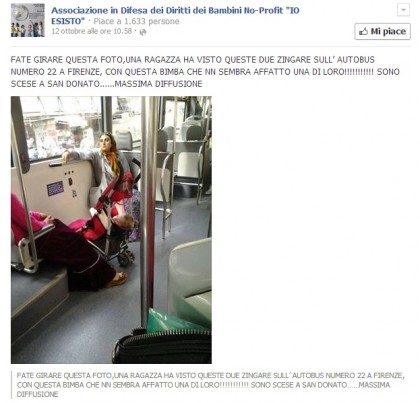Gypsies as Children Stealers in Italy: A Modern Myth December 24, 2014
Author: Beach Combing | in : Contemporary, Medieval , trackbackAs noted previously on this blog the idea that gypsies steal children is an old one, at least five hundred years old if one piece of medieval German legislation is to be taken seriously. It is an idea that has died out in most western countries, but one that has survived curiously in Italy where, a couple of years ago, Beach’s sister-in-law talked about helping a crowd burn a local gypsy (aka zingari, Roma) camp and where Little Miss B, aged six, has already learnt that ‘gypsies steal kids’ (courtesy of our housekeeper). The view is held by many people in public life. Rino Monaco who is the Commissioner for the Disappeared has gone on record as saying that ‘cases of the Rom stealing children is in no way legend.’ Lega Nord, Italy’s most hysterical political party recently asked for the government to inspect gypsy camps looking for stolen children. And Rita Pedditzi, a capable Italian journalist, who has written a book on disappeared children, talks of some ten attempts on the part of zingari to steal children between 2004 and 2013. Is this prejudice or is there something like facts behind these assertions?
The first thing to say is that Italy has a very varied gypsy population. There is a great deal of difference between established Italian zingari, who have been in the country for generations; and recent arrivals from Kosova or Romania. It is also true to say that some of Italy’s Roma population are involved in crime. They are involved in crime, (i) because they live outside the system and so do not, for instance, pay taxes and (ii) because some are involved in agressive and anti-social crimes against their neighbours. There is certainly the presumption of higher levels of criminality among Roma populations on the part of most Italians: and from some personal experiences Beach would subscribe to that view. But this leads us to the crime of stealing children, something much more serious than illegal begging or petty stealing or even mugging.
Do the Roma steal children? Rino Monaco (quoted above), Italian Commissioner for the Disappeared in 2008, said that they do, but RM made the important distinction that most cases of stealing took place between Roma clans, particularly when one family moved out of a nomad camp. Monaco uses the word ‘normally’ (‘di solito: in other interviews he has been more circumspect). But, in fact, there has never been a case in Italy where a Roma has been found guilty in a court of law of stealing Italian children. There have been though some instances that are instructive. In July 2007, a group of zingari went onto a beach at the Isole della Femmine near Palermo. A gypsy woman put an Italian child’s head beneath her dress: at which point a lifeguard began to scream. The gypsies fled (without the child) and the woman was later found at the train station and arrested. When the case came to court the judge dismissed it out of hand speaking of ‘hallucinations’ and ‘collective psychosis’. A friendly action on the part of the gypsy woman, he said, had been misinterpreted by anxious parents on the sands.
Another fascinating case came 12 May, 2008 in Ponticelli (near Naples) when a Roma woman entered a local house, took up a baby from a crib and ran for the door. Riots against a local gypsy camp followed. The problem with this story is that it was an invention. The Roma woman had entered the house of a local strongman: the mother was the wife of a Camorra head. This is not a place that you would normally choose to steal anything!! Various inconsistencies in the mother’s account have undermined her credibility and the fact that the Camorra had decided to push out the local Roma population for their own nefarious purposes is likely the explanation for this non event. In other words the Camorra whipped up a pogrom. An Italian journalist, Marco Imarisio dedicated a book to explaining the pogrom’s background in Neapolitan organised crime: the camp being burned at the head of the post was the result. Ten days after another ‘kidnapping’ attempt took place in Catania (Sicily), when a woman believed that her child was about to be stolen by a group of gypsies outside a supermarket. The story sounds very much like an understandably panicked woman coming face to face with outrageously agressive begging tactics on the part of a small gypsy group. Two zingari were arrested and, it goes without saying, that neither were charged with kidnapping.
But what about children that have actually gone missing. The most famous example of a gypsy kidnapping in Italy was that of Denise Pipitone, a child who tragically and inexplicably disappeared 9 September 2004 in Sicily. Rita Pedditzi, a journalist quoted above, has gone on record as saying that ‘the prevalent hypothesis’ was that Denise had been carried off to a local gypsy camp. This case too though has now vanished from the gypsy record as a family member is finally, twenty years later, being prosecuted for her murder. Italian social media and blogs do sometimes show, see the example above, photographs of Italian gypsies with blond children with requests to circulate, the implication being that the real parents are out there somewhere. None of this is to say that gypsies based in Italy have never ever stolen gaji children. But these simple facts gathered here should confirm that: (i) such kidnappings are neither habitual nor even occasional; but also that (ii) many Italians are hardwired to explain children disappearing with reference to zingari and that they are wrong to do so. When the furious mob descended on the gypsies of Ponticelli in 2008 they had no idea that they were re-enacting a scene from the Middle Ages.




